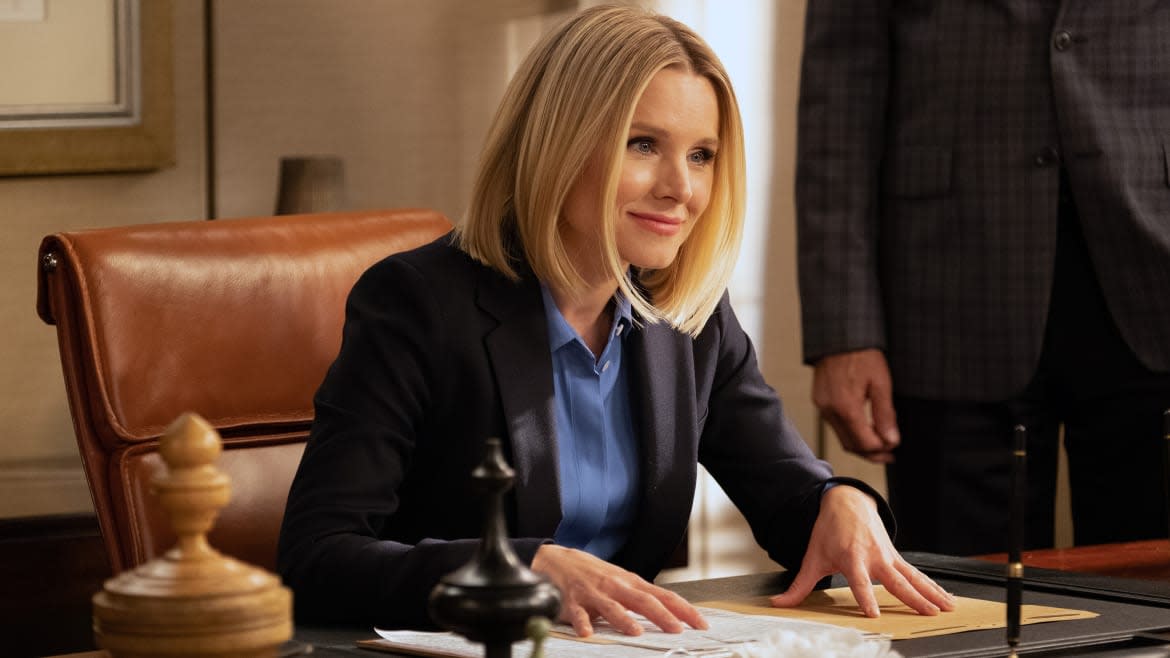In Its Final Season, ‘The Good Place’ Goes Back to Where It All Began

After a weak third season that struggled to break free from a tedious, cyclical plot, the fourth season of The Good Place, which premiered Thursday evening on NBC, brings its characters back to the neighborhood where it all began, complete with candy-colored cobblestone streets and an abundance of frozen yogurt shops.
Jason Mendoza (Manny Jacinto), the hip-hop-dancing Blake Bortles superfan from Jacksonville, Florida, is back in his yellow robes, posing as the pensive Tibetan monk Jianyu. Pakistani-British socialite Tahani Al-Jamil (Jameela Jamil) who prefers to namedrop in threes, is once again hosting fabulous parties for the other Good Place residents. Self-proclaimed “Arizona dirtbag” Eleanor Shellstrop, played by Kristen Bell, has stepped in as leader of the new neighborhood, under the guidance of reformed demon Michael (Ted Danson).
When season three wrapped up, this ragtag crew of the damned had convinced the Judge of the Universe (a hilarious, gesticulating Maya Rudolph) to let them test their theory that human beings are too complex to be sorted into good and bad; that anyone is capable of goodness if given the chance to learn and grow. Under the terms of the experiment, a demon named Shawn (Marc Evan Jackson), the show’s monotone, insult-hurling answer to Satan, gets to choose four new humans to test the hypothesis, on the condition that they are all similar levels of “badness” to the original four. Then, Michael gets to create and populate the neighborhood where the experiment will take place. The team has a year to show the judge that their four guinea pigs have become good.
Though the four new neighbors in the Good Place are not quite as charming as the original squad of sinners, they provide plenty of fodder for new jokes and play with our different definitions of what constitutes a bad (but not so bad) person. First to arrive in the neighborhood is John (Brandon Scott Jones), a bitchy gossip columnist sent to torment Tahani, whom he regularly dragged on his blog. There’s also Simone (Kirby Howell-Baptiste), a familiar face from last season, and an old woman whose only offense seems to be that she is mind-numbingly boring. Last up is Brent (Ben Koldyke), a middle-aged poster child for white privilege. He hates Captain Marvel and wants everyone to know that he got into Princeton the old-fashioned way, no shortcuts—just like his father, and his father’s father.
Bringing the action back to the familiar setting of the first season is a clever and poignant plot device for the show’s final run, as it is both safe territory for the writers—we know it worked the first time—and nostalgic for fans of the show to look back on how much has changed since the beginning. Adding to the emotional stakes, a final plot twist from the season three finale forces Chidi Anagonye (William Harper Jackson) to agree to completely erase his memory of everything that happened after he died, including his passionate, on-and-off relationship with Eleanor.
Though the four episodes made available to critics for review are hardly enough to evaluate the entire fourteen-episode season, my initial response is relief that the show is ending. This is not because it isn’t enjoyable to watch; it definitely is. One of the greatest strengths of The Good Place is simply its capacity to make viewers smile. The demons who lord over the Bad Place—the evilest beings in existence—call people “turd balls” and “d-bags,” and their preferred method of torture is flattening and re-inflating penises.
In season four, the jokes are as funny as ever, especially those that allow Ted Danson to shine in his role as an out-of-touch dad-type calling out the bizarre intricacies of human behavior, which he does not understand, of course, because his true form is that of a 6,000-foot “fire squid.” In the fourth episode, he matter-of-factly describes the phrase, “So great running into you, we should get coffee sometime” as an “inspirational lie.” D’Arcy Carden is also consistently amusing as Janet, an AI-like repository for all of the knowledge in the world, who has become increasingly human and struggles to understand her romantic feelings for Jason.
But it’s easy to get distracted by the punchlines and ignore that there isn’t much farther for this serialized show’s plot to go, and the result is a reliance on repetitive twists that just don’t have the same oomph they once did.
This is a difficult show to review if only because the web of twists and turns for which it is known has grown so complex over the past three years, and its language is so specific to the bizarre, colorful Michael Schur-created universe, that the simplest detail often requires an extensive explanation invoking phrases like “reboot,” “Jeremy Bearimy,” and “skinsuit.” I imagine it is similar to explaining Game of Thrones to an elderly relative, if characters from GOT said “fork” instead of “fuck.”
The Good Place’s ambition in tackling philosophical questions about morality and the afterlife in a half-hour network sitcom is what initially made it such a breath of fresh air. However, when basing an entire series on trying to answer life’s unanswerable questions, you are bound to hit a wall eventually. With the end of The Good Place, the bleak sitcom landscape is losing one of its strongest, funniest, most delightfully weird television shows. But all good things must come to an end, and in this case, the end feels overdue.
Got a tip? Send it to The Daily Beast here
Get our top stories in your inbox every day. Sign up now!
Daily Beast Membership: Beast Inside goes deeper on the stories that matter to you. Learn more.

